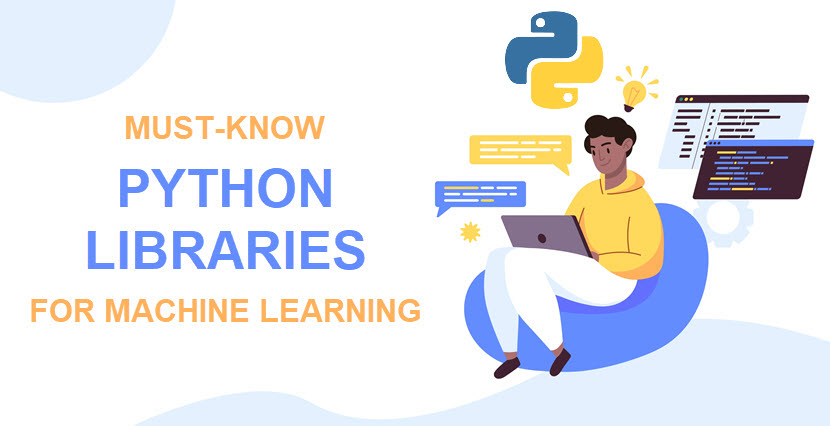Python is one of the most commonly used programming languages in artificial intelligence (AI) and machine learning (ML) development. Developers value this language due to its user-friendly syntax, high flexibility, and, most importantly, its rich selection of available libraries.
Python libraries offer ready-made tools, functions, and algorithms. Instead of writing code from scratch, developers take high-quality components from these libraries and plug them into their own code base.
This article presents every major Python machine learning library that AI and ML developers must know how and when to use. Jump in to see what Python libraries you can use to speed up and simplify the development of ML models.

Python is highly popular due to its ease of use and numerous libraries, but it's not the only language AI developers use. Learn what other languages are an excellent fit for AI projects in our article on AI programming languages.
10 Best Python Libraries for Machine Learning
There are hundreds of Python libraries to choose from if you are an ML developer, but a few of them clearly stand out in terms of popularity and quality. Let's examine the most popular Python libraries commonly used in the machine learning niche.
TensorFlow
TensorFlow is an open-source library that offers a rich ecosystem of tools, modules, and APIs for building and deploying ML-powered applications.

This library supports eager execution, a mode that allows you to run operations immediately as they are called from Python. Users get results immediately, eliminating the need to create and run a session. Eager execution simplifies debugging, makes development more intuitive, and enables efficient computations in large-scale ML tasks.
Here is what this Python machine learning library offers:
- Fundamental ML data structures and mathematical functions.
- A repository for reusable machine learning modules (TensorFlow Hub).
- Components for building and deploying production ML pipelines.
- Pre-built estimators for common machine learning tasks.
- Tools for efficient data loading and preprocessing.
- A repository of pre-trained ML models.
- Tools for deploying models on mobile and embedded devices.
- Visualization tools for monitoring and debugging workflows.
- Various community-contributed extensions and components.
Here are the main selling points of TensorFlow:
- Flexibility. The ability to run on multiple platforms (CPUs, GPUs, TPUs, mobile, and embedded devices) and distribute training across multiple resources makes TensorFlow highly flexible.
- Excellent performance. TensorFlow is designed for high-performance execution and parallelism. These characteristics are crucial for ML training and inference. Additionally, transitioning from shared to distributed memory is seamless, which further boosts performance and ensures scalability.
- A comprehensive ecosystem. This library offers a variety of tools, pre-trained models, and components that speed up ML projects. Developers get tools for every stage of the ML lifecycle.
TensorFlow's ability to handle large data sets and perform complex computations efficiently makes it a popular choice for computer vision (image recognition, object detection, image segmentation) and natural language processing (NLP) tasks. The library is also a go-to option when working on deep learning projects.
TensorFlow's suitability for deep learning tasks makes this library one of the most popular deep learning frameworks currently on the market.
PyTorch
PyTorch is an open-source machine learning library based on Torch, a scientific computing framework for ML algorithms. This library's prime focus is on computer vision and NLP, but PyTorch is also well-suited for AI and ML experimentation.

PyTorch offers a high-level interface that simplifies the implementation of complex neural network architectures while maintaining the flexibility to customize models. Here is what developers get from the PyTorch library:
- An automatic differentiation engine for computing gradients.
- Core data structures similar to NumPy arrays but with GPU acceleration.
- A neural network library (the torch.nn module) of predefined layers, loss functions, and optimizers.
- Dynamic computation graphs available to be modified on the fly.
- Tools and data sets for NLP (Torchtext) and audio processing (Torchaudio).
- Utilities for computer vision applications (Torchvision).
- Tools for visualizing training progress and metrics.
- A high-level framework that abstracts away much of the boilerplate code (PyTorch Lightning).
Here is why PyTorch earned a place on this list:
- Dynamic computation graphs. PyTorch enables developers to modify graphs on the go, which significantly aids in debugging and experimentation.
- Customization. Pytorch is highly customizable, which makes it easier to develop complex models and create prototypes.
- Ease of use. PyTorch is highly intuitive and is one of the most accessible Python libraries to learn and use. A strong and growing community also means newcomers have extensive resources to master PyTorch.
Machine learning developers use PyTorch for a wide range of tasks that benefit from flexibility and simpler experimentation. In addition to computer vision and NLP tasks, PyTorch is a common choice for creating generative models like GANs (Generative Adversarial Networks) and deep neural networks (especially those trained via reinforcement learning).
Our head-to-head comparison of PyTorch and TensorFlow explains the main differences between arguably the two most popular Python-based ML libraries.
Scikit-Learn
Scikit-learn is an open-source Python machine learning library that provides efficient tools for data analysis and modeling. This library simplifies the creation and implementation of a wide range of classification, regression, and dimensionality reduction algorithms.

Scikit-learn is known for its ease of use and clean API that simplifies the implementation of both supervised and unsupervised learning methods. Here's what this library offers:
- Tools for classification (e.g., SVM, decision trees) and regression (e.g., linear regression, ridge regression).
- Cross-validation, grid search, and metrics for evaluating model performance.
- Methods for clustering (e.g., K-means, DBSCAN) and dimensionality reduction (e.g., PCA, t-SNE).
- Tools for normalization, scaling, and encoding categorical variables.
- Utilities for feature extraction.
- Tools for creating workflows that streamline model preprocessing, training, and evaluation.
- Built-in data sets and functions for generating synthetic data.
Here is why we decided to include Scikit-learn in this article:
- Interoperability. This library seamlessly integrates with other Python frameworks like NumPy, SciPy, and Matplotlib.
- Wide range of algorithms. Scikit-learn offers an impressively broad spectrum of machine learning algorithms.
- High performance. Scikit-learn enables efficient implementations of algorithms that scale well with data size.
Scikit-learn is well-suited for classical machine learning tasks such as classification, regression, clustering, and dimensionality reduction. The library's extensive documentation makes it an excellent starting point for those new to ML, while its robust performance and scalability cater to more advanced users.
Our article on regression algorithms presents 10 different types of algorithms we wrote with the help of the Scikit-learn library.
Keras
Keras is an open-source, high-level neural network library that enables fast experimentation with deep learning models.

Keras's primary goal is to simplify the process of building, training, and deploying neural networks. Its native integration with TensorFlow allows developers to leverage TensorFlow's power and scalability while enjoying Keras's simplicity and ease of use. Here is an overview of what you will find in the Keras library:
- A variety of layer types, such as dense, convolutional, recurrent, and dropout layers.
- Numerous optimization algorithms, including SGD, Adam, RMSprop, and more.
- Various loss (mean squared error, categorical crossentropy, binary crossentropy) and activation functions (ReLU, Sigmoid, Tanh).
- Tools for customizing model training processes, like early stopping, learning rate scheduling, and model checkpointing.
- Utilities for data preprocessing, augmentation, and generation.
- A hyperparameter optimization library for enhancing model performance.
- Functions for evaluating model performance.
Below are the main pros of this Python ML library:
- An accent on simplicity. Keras' main selling point is that it simplifies the process of building and training complex neural networks.
- Flexibility. Keras supports multiple backends (TensorFlow, CNTK, Theano) and can be easily expanded with custom layers and functions.
- Excellent modularity. Keras is highly modular, a design that allows for easy customization and extension of models.
Keras' support for recurrent layers makes the library ideal for handling sequential data. Keras also supports embedding layers for word representation and tools for processing text data, which makes it easier to develop sophisticated NLP models.
Additionally, Keras is used in various other domains, such as speech recognition, recommendation systems, and time series forecasting. Its integration with TensorFlow allows for deployment on multiple platforms, making Keras a versatile tool for both research and production ML environments.
XGBoost
XGBoost is an open-source library designed for implementing gradient boosting algorithms. Gradient boosting is an ML technique that builds a predictive model by combining the outputs of several weak learners to create a strong learner.

Thanks to parallel tree boosting, XGBoost is highly efficient, flexible, and portable. It can be deployed across various platforms or distributed environments. XGBoost also includes a variety of interfaces, making it accessible to a broad range of users.
Here's an overview of what you get from the XGBoost library:
- Techniques to prevent overfitting, including depth-wise and leaf-wise tree growth.
- The core implementation of the gradient boosting algorithm.
- Tools for cross-validation and hyperparameter tuning.
- L1 (Lasso) and L2 (Ridge) regularization to control model complexity.
- Early stopping mechanisms that halt training when performance metrics stop improving.
- Methods for evaluating features in the model.
Let's examine the main selling points of XGBoost:
- High performance. XGBoost utilizes multi-threading and parallelism to ensure fast computation. The library easily works with large data sets and within distributed computing environments.
- Broad scope. XGBoost's robust framework supports a range of standard machine learning tasks, such as classification, regression, and ranking. The library also provides top-tier tools for model evaluation, feature importance analysis, and hyperparameter tuning.
- Flexibility. XGBoost has interfaces for several popular programming languages (Python, R, Julia, Java) and supports various types of objective functions and custom loss functions.
XGBoost is one of the most popular and widely used machine learning libraries for structured or tabular data (i.e., data displayed in columns or tables). The library's ability to handle large data sets and missing values efficiently makes it suitable for large-scale classification problems (e.g., fraud detection, customer churn prediction, disease diagnosis).
LightGBM
LightGBM is an open-source, high-performance gradient boosting framework. This library is known for the ability to handle categorical features directly without one-hot encoding, which simplifies preprocessing and improves performance.

Here's an overview of what this Python machine learning library offers to developers:
- Components for implementing gradient boosting algorithms.
- Capabilities for training models in parallel and distributed computing environments.
- Advanced techniques for reducing computation times and improving accuracy (e.g., histogram-based decision trees and leaf-wise tree growth).
- Tools for evaluating model performance using cross-validation techniques.
- Mechanisms to halt training when performance stops improving.
- Functions for feature importance analysis.
Below are the main advantages of using LightGBM:
- High efficiency. LightGBM ensures fast training and lower memory usage due to histogram-based learning and leaf-wise growth.
- Versatility. LightGBM supports a wide range of tasks, including classification, regression, and ranking. Its seamless integration with popular data science tools and languages (Python, R, C++) further extends the library's usability.
- Parallel and distributed training. Parallel and distributed model training capabilities enhance scalability and enable models to achieve higher accuracy than other gradient boosting implementations. LightGBM also supports GPU computing acceleration.
LightGBM's mix of speed, scalability, and performance makes it a go-to choice for building fast and accurate ML models. The library's support for categorical features also simplifies the preprocessing pipeline, enabling developers to build and deploy models more quickly.
In classification problems, LightGBM is commonly applied to tasks such as fraud detection, customer segmentation, and disease diagnosis. In regression tasks, LightGBM is often used to predict continuous values, such as housing prices, stock market trends, or sales figures.
NumPy
NumPy is a library designed for scientific computing using Python. It provides essential tools for handling large arrays and matrices, along with a comprehensive set of functions for performing operations on these arrays.

NumPy's array object (ndarray) is central to the library's functionality. This object efficiently stores and manipulates data sets, enabling fast and memory-efficient computations.
The list below offers an overview of what you will find in the NumPy library:
- Multi-dimensional arrays for efficient storage and manipulation of large data sets.
- A library of mathematical functions for array operations (element-wise operations, linear algebra, statistical functions, etc.).
- Tools for reshaping, stacking, and splitting arrays.
- A mechanism to perform operations on arrays of different shapes.
- Tools for generating random numbers for various probability distributions.
- Utilities for reading from and writing to disk, including support for CSV, binary, and text files.
Here are the main reasons why Python developers use NumPy:
- Top-tier performance. NumPy arrays are optimized for performance, so they ensure fast operations even when working with large data sets.
- Integration options. NumPy integrates with other Python libraries, including SciPy, Pandas, and Matplotlib. This interoperability enables developers to build comprehensive data analysis and visualization workflows.
- Versatility. NumPy supports various mathematical and statistical functions.
Machine learning developers use NumPy extensively for data manipulation, numerical computations, and preprocessing tasks. NumPy arrays often serve as the primary data structure for holding and transforming data before it is fed into a machine learning model. Typical tasks in this area include:
- Normalizing data.
- Performing element-wise operations.
- Reshaping data sets to the required format.
In addition to data preparation, NumPy is often used to implement custom machine learning algorithms and perform numerical experiments.
SpaCy
SpaCy is an open-source library for advanced NLP tasks in Python. This library provides a robust, efficient, and user-friendly framework for preprocessing text data or extracting linguistic features before applying more complex machine learning algorithms.

SpaCy offers pre-trained, ready-to-use models for multiple languages and can handle large volumes of text quickly and accurately. Here is what else you'll find in the SpaCy library:
- Efficient and accurate splitting of text into tokens.
- Analysis of the syntactic structure of sentences.
- Part-of-speech tagging capabilities.
- Lemmatization capabilities for reducing words to their base or dictionary form.
- Named Entity Recognition (NER) for identifying and classifying named entities in text.
- Integrations with word embeddings (Word2Vec, GloVe, and fastText).
Let's look at the main advantages of this Python library:
- Comprehensive pre-trained models. SpaCy offers pre-trained models that provide high accuracy out of the box and eliminate the need to create models from scratch.
- Integration options. SpaCy's seamless integration with TensorFlow and PyTorch enables developers to build NLP models that leverage the strengths of traditional NLP features and deep learning approaches.
- Performance and efficiency. SpaCy's underlying Cython implementation ensures that NLP tasks are executed quickly. This speed makes the library suitable for real-time applications and large-scale processing.
Machine learning developers often use SpaCy to integrate NLP with machine learning workflows. SpaCy's ability to handle word vectors and compatibility with deep learning frameworks make it an excellent choice for creating embeddings and training models on custom data sets.
Pandas
Pandas is an open-source data manipulation library widely used in data science, data analysis, and machine learning. This library is a powerful tool for both handling and analyzing data sets.

Pandas is designed to handle various data formats and is suitable for various processing tasks. The library is indispensable for data preparation and analysis due to its extensive functionalities. Here is what you can find in the Pandas library:
- Tools for handling missing values, filtering files, and transforming data.
- Functions to read from and write to various file formats (CSV, Excel, SQL, etc.).
- Advanced data-related features, such as handling hierarchical indexing, merging and joining data sets, and multi-indexing.
- Functions for handling and analyzing time series data.
- Tools for grouping, summarizing, and aggregating data.
- Flexible data selection and indexing options.
- Tools for pivoting, melting, and reshaping data for analysis.
Below are the three main selling points of the Pandas library:
- Comprehensive data handling. The library supports various data operations, including cleaning, merging, reshaping, and aggregating.
- Integration with other libraries. Pandas integrates seamlessly with NumPy, Matplotlib, and SciPy. This interoperability allows for the creation of robust data analysis and visualization pipelines.
- Ease of use. Pandas' intuitive and user-friendly syntax helps speed up the development and prototyping of data-related workflows.
Machine learning developers use Pandas extensively for data preprocessing and exploration, two critical steps in every ML pipeline. Before building models, developers must clean and prepare their data, which often involves tasks like:
- Handling missing values.
- Filtering out irrelevant information.
- Transforming data into suitable formats.
Pandas provides a rich set of tools for these tasks, allowing developers to preprocess data quickly, efficiently, and accurately.
Matplotlib
Matplotlib is a Python library for creating static, animated, and interactive visualizations. This library provides a flexible platform for creating a wide range of plots and charts and is commonly used in the machine learning niche to visualize data.

Here is what the Matplotlib library offers to users:
- Various basic (line plots, scatter plots, bar charts, histograms, pie charts) and advanced plots (3D plots, contour plots, quiver plots).
- Tools for creating complex multi-plot layouts.
- Extensive options for customizing plots, including labels, titles, legends, tick marks, and colors.
- Support for interactive plots with pan, zoom, and update capabilities.
- Functions for creating animated plots and visualizations.
- Tools for embedding plots in applications and web pages.
- Predefined styles and themes for visualizations.
Here are the main pros of Matplotlib:
- Wide range of plot types. The library supports various plot types, from simple line and bar charts to complex 3D and animated plots.
- Interactive plotting. Matplotlib supports interactive plotting through various backends. This feature allows users to enhance their understanding of data.
- Extensive customization. Matplotlib allows users to customize every aspect of a plot. Users get to create highly detailed and tailored plots that meet specific requirements.
Machine learning developers use Matplotlib primarily to visualize data. During the exploratory data analysis (EDA) phase, developers often use Matplotlib to create various plots to understand data distributions, relationships, and trends. This process helps in feature selection and engineering.
In addition to EDA, Matplotlib is used to visualize the performance of deployed machine learning models. Developers often create line plots to monitor accuracy, precision, recall, and loss over time. Matplotlib integrates seamlessly with NumPy, Pandas, and SciPy, so users can create visualizations directly from their data workflows.
How to Choose a Python Machine Learning Library
Here are some general pointers on when to use the Python libraries covered in this article:
- Use TensorFlow to build and deploy deep learning models. This library is ideal for projects that require robust, scalable solutions and deployment in varied production environments.
- Scikit-learn is ideal for standard machine learning tasks such as classification, regression, clustering, and dimensionality reduction. This library is also an excellent choice for those new to machine learning due to its straightforward API and detailed documentation.
- Use Keras to quickly build and prototype deep learning models with a user-friendly API. Since Keras integrates with TensorFlow, it benefits from TensorFlow's performance boosts while providing a considerably simpler interface.
- PyTorch is ideal for experimentation and prototyping thanks to its dynamic computation graphs and flexibility. Like TensorFlow, PyTorch excels at building deep learning models.
- Go with XGBoost if you want to perform gradient boosting tasks on structured or tabular data.
- Use LightGBM to handle extremely large data sets efficiently with gradient boosting algorithms.
- NumPy is fundamental for numerical operations in Python. Use this library for array operations, linear algebra, and other mathematical functions.
- Add SpaCy to your workflows if your ML project involves NLP tasks such as tokenization, part-of-speech tagging, named entity recognition, or dependency parsing.
- Pandas is the go-to option for data manipulation and analysis tasks. Pandas excels at cleaning, transforming, and preparing data for machine learning models.
- Matplotlib is a common choice for creating static, animated, and interactive visualizations in Python. Use Matplotlib to create detailed and customized plots that visualize data distributions, trends, and relationships within the ML model.
Machine learning is groundbreaking, but ML is not the only AI technology worth implementing. Check out our article on the most impactful AI technologies to see what else you can use to streamline and accelerate your workflows.
Get Your ML Project Off to a Good and Fast Start
If you write code from scratch, even a small machine learning project would take months to get going. Luckily, there's no need to approach ML development this way. Use what you learned here to ensure your development team knows how to use the valuable shortcuts offered by the Python libraries discussed in this article.



